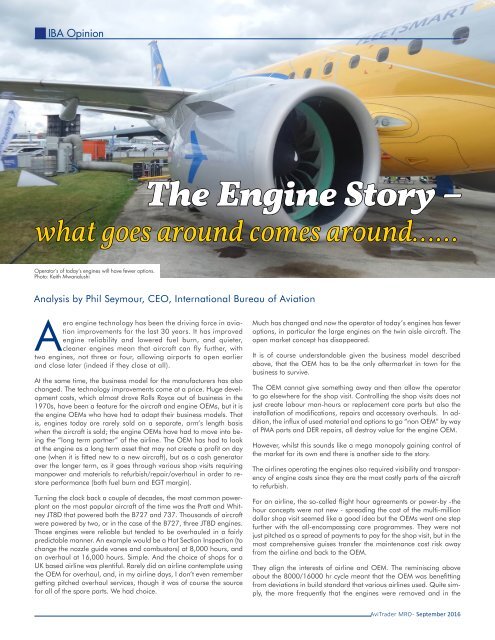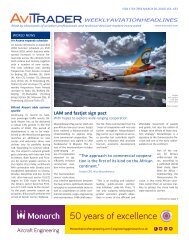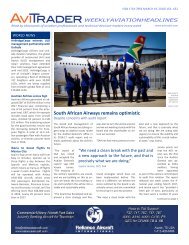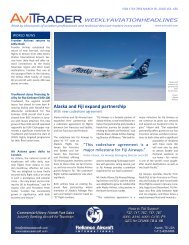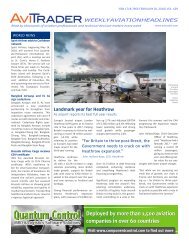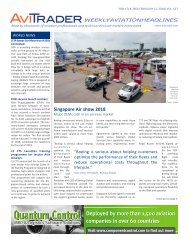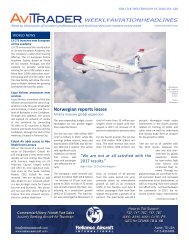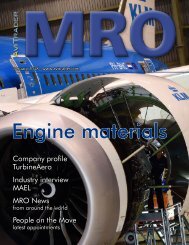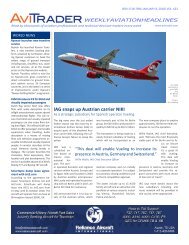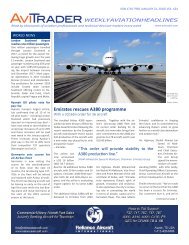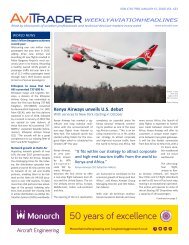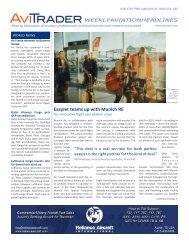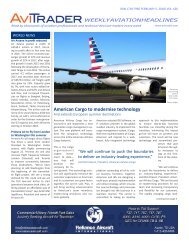AviTrader_Monthly_MRO_e-Magazine_2016-09
AviTrader_Monthly_MRO_e-Magazine_2016-09
AviTrader_Monthly_MRO_e-Magazine_2016-09
Create successful ePaper yourself
Turn your PDF publications into a flip-book with our unique Google optimized e-Paper software.
IBA Opinion<br />
21<br />
The Engine Story –<br />
what goes around comes around……<br />
Operator’s of today’s engines will have fewer options.<br />
Photo: Keith Mwanalushi<br />
Analysis by Phil Seymour, CEO, International Bureau of Aviation<br />
A<br />
ero engine technology has been the driving force in aviation<br />
improvements for the last 30 years. It has improved<br />
engine reliability and lowered fuel burn, and quieter,<br />
cleaner engines mean that aircraft can fly further, with<br />
two engines, not three or four, allowing airports to open earlier<br />
and close later (indeed if they close at all).<br />
At the same time, the business model for the manufacturers has also<br />
changed. The technology improvements come at a price. Huge development<br />
costs, which almost drove Rolls Royce out of business in the<br />
1970s, have been a feature for the aircraft and engine OEMs, but it is<br />
the engine OEMs who have had to adapt their business models. That<br />
is, engines today are rarely sold on a separate, arm’s length basis<br />
when the aircraft is sold; the engine OEMs have had to move into being<br />
the “long term partner” of the airline. The OEM has had to look<br />
at the engine as a long term asset that may not create a profit on day<br />
one (when it is fitted new to a new aircraft), but as a cash generator<br />
over the longer term, as it goes through various shop visits requiring<br />
manpower and materials to refurbish/repair/overhaul in order to restore<br />
performance (both fuel burn and EGT margin).<br />
Turning the clock back a couple of decades, the most common powerplant<br />
on the most popular aircraft of the time was the Pratt and Whitney<br />
JT8D that powered both the B727 and 737. Thousands of aircraft<br />
were powered by two, or in the case of the B727, three JT8D engines.<br />
Those engines were reliable but tended to be overhauled in a fairly<br />
predictable manner. An example would be a Hot Section Inspection (to<br />
change the nozzle guide vanes and combustors) at 8,000 hours, and<br />
an overhaul at 16,000 hours. Simple. And the choice of shops for a<br />
UK based airline was plentiful. Rarely did an airline contemplate using<br />
the OEM for overhaul, and, in my airline days, I don’t even remember<br />
getting pitched overhaul services, though it was of course the source<br />
for all of the spare parts. We had choice.<br />
Much has changed and now the operator of today’s engines has fewer<br />
options, in particular the large engines on the twin aisle aircraft. The<br />
open market concept has disappeared.<br />
It is of course understandable given the business model described<br />
above, that the OEM has to be the only aftermarket in town for the<br />
business to survive.<br />
The OEM cannot give something away and then allow the operator<br />
to go elsewhere for the shop visit. Controlling the shop visits does not<br />
just create labour man-hours or replacement core parts but also the<br />
installation of modifications, repairs and accessory overhauls. In addition,<br />
the influx of used material and options to go “non OEM” by way<br />
of PMA parts and DER repairs, all destroy value for the engine OEM.<br />
However, whilst this sounds like a mega monopoly gaining control of<br />
the market for its own end there is another side to the story.<br />
The airlines operating the engines also required visibility and transparency<br />
of engine costs since they are the most costly parts of the aircraft<br />
to refurbish.<br />
For an airline, the so-called flight hour agreements or power-by -the<br />
hour concepts were not new - spreading the cost of the multi-million<br />
dollar shop visit seemed like a good idea but the OEMs went one step<br />
further with the all-encompassing care programmes. They were not<br />
just pitched as a spread of payments to pay for the shop visit, but in the<br />
most comprehensive guises transfer the maintenance cost risk away<br />
from the airline and back to the OEM.<br />
They align the interests of airline and OEM. The reminiscing above<br />
about the 8000/16000 hr cycle meant that the OEM was benefitting<br />
from deviations in build standard that various airlines used. Quite simply,<br />
the more frequently that the engines were removed and in the<br />
<strong>AviTrader</strong> <strong>MRO</strong> - September <strong>2016</strong>


